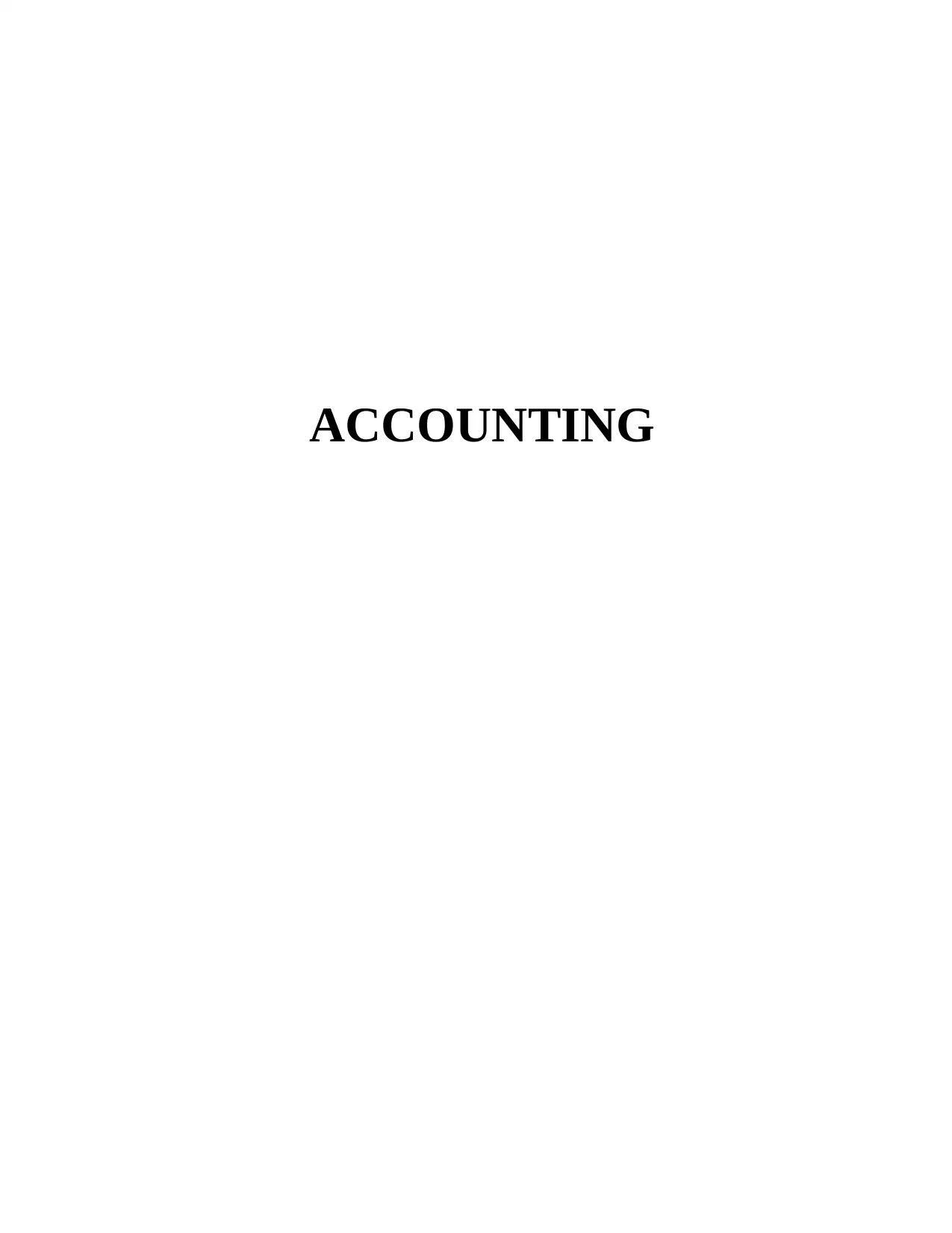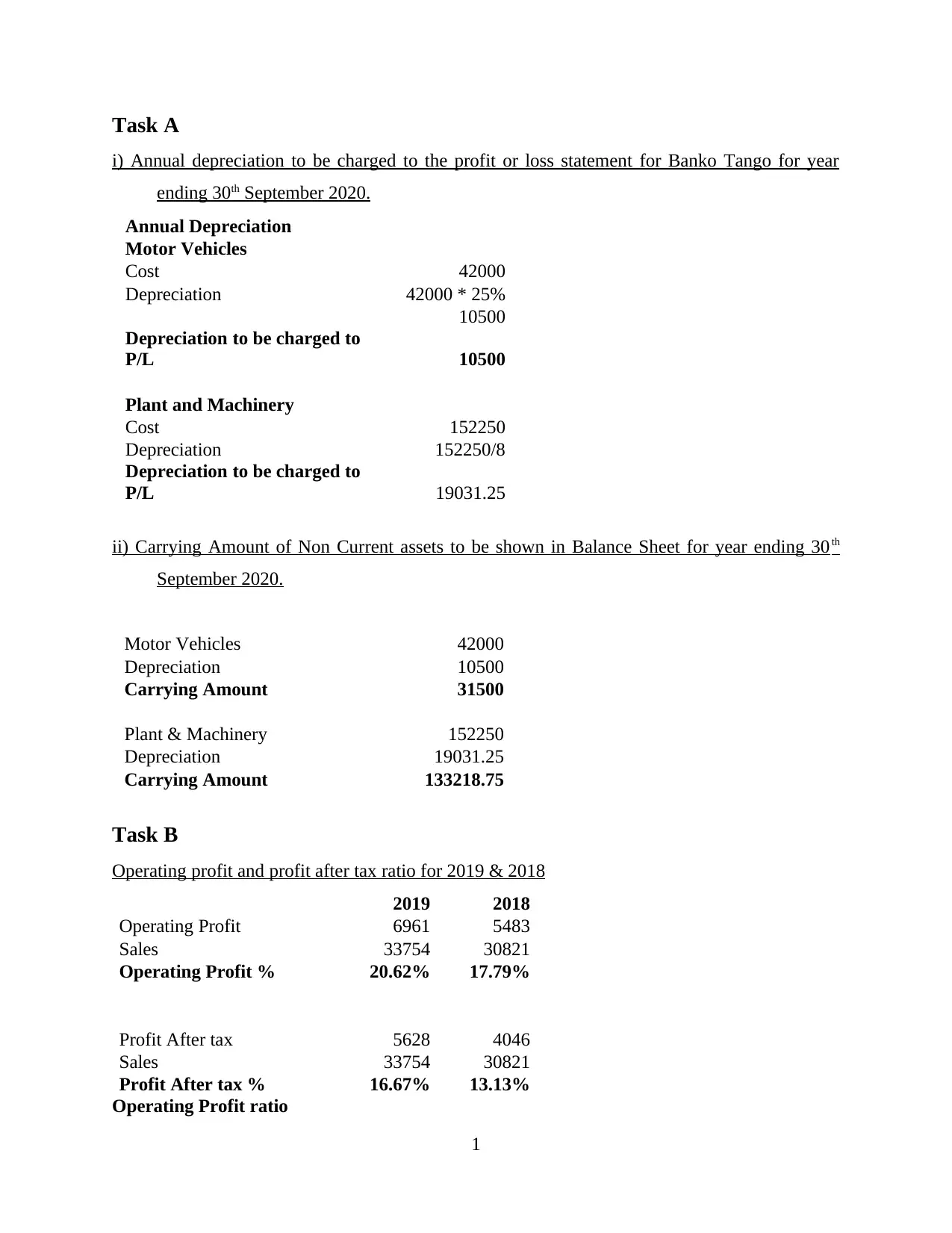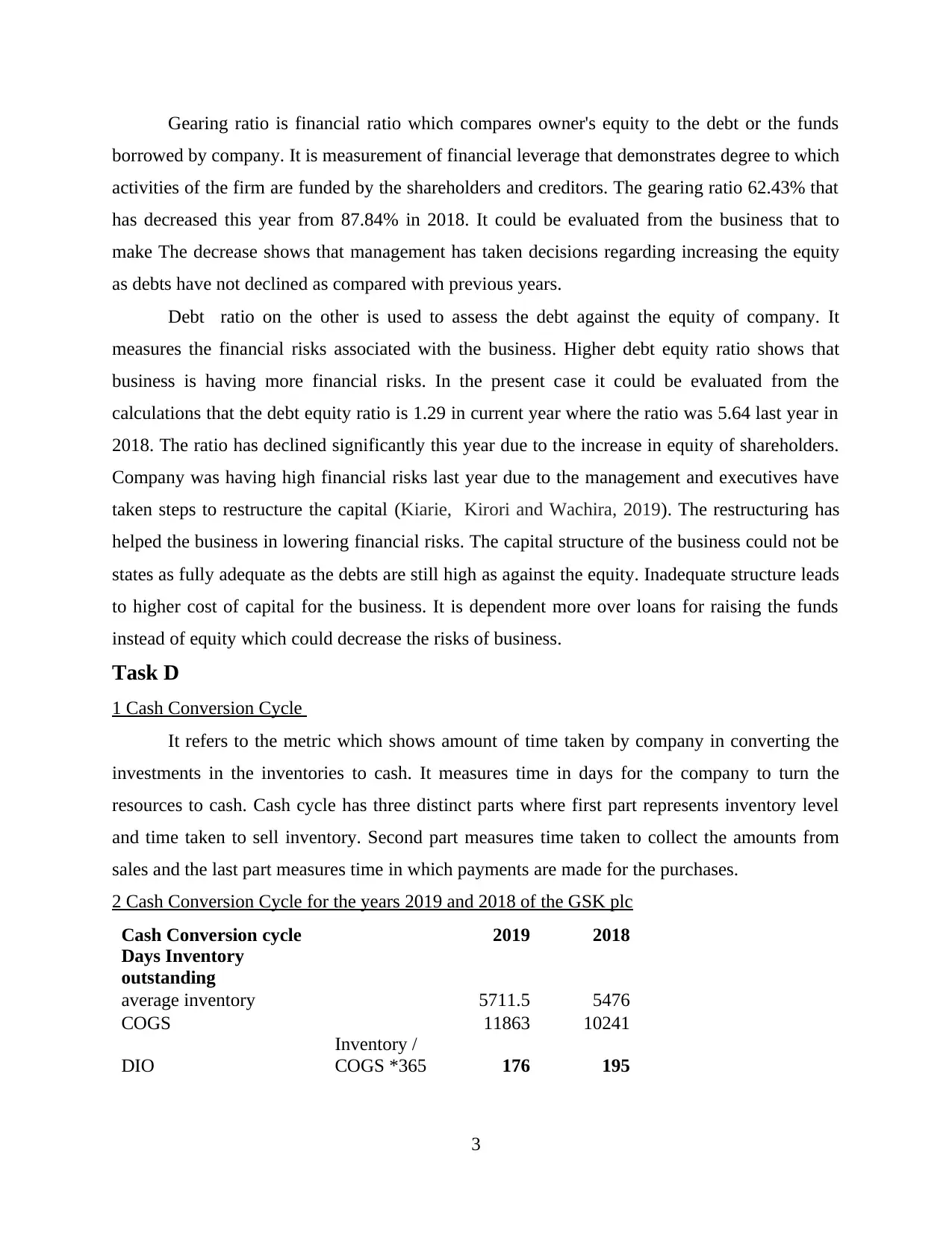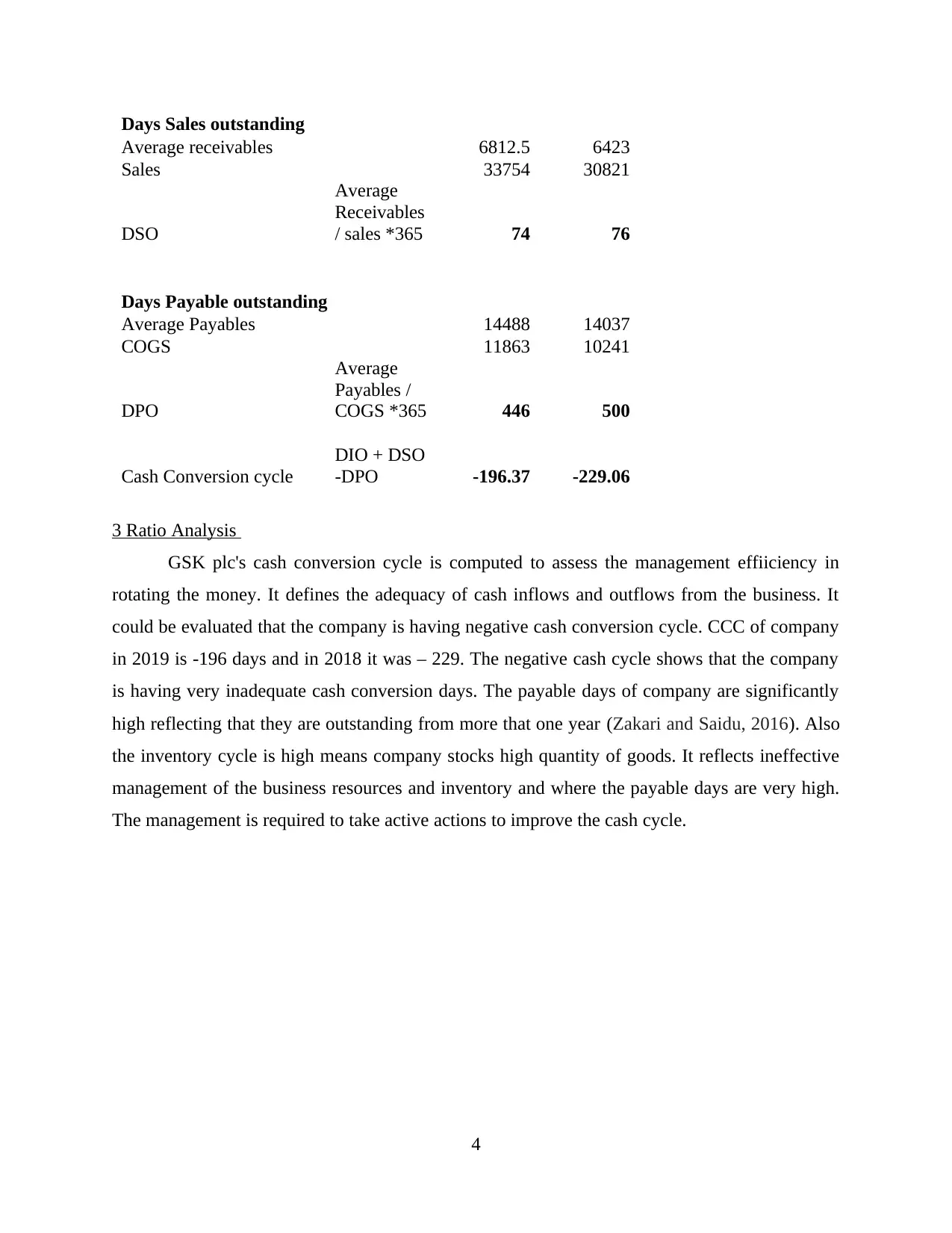Comprehensive Accounting and Financial Analysis Report for Banko Tango
VerifiedAdded on 2022/12/30
|7
|1386
|55
Report
AI Summary
This accounting report presents a detailed financial analysis of Banko Tango. Task A calculates annual depreciation for motor vehicles and plant & machinery, as well as the carrying amounts of non-current assets. Task B analyzes operating profit and profit after tax ratios for 2019 and 2018, evaluating management efficiency and profitability trends. Task C examines gearing and debt ratios, assessing financial leverage and risk. Task D focuses on the cash conversion cycle, analyzing the performance of GSK plc in 2019 and 2018, along with ratio analysis to assess the efficiency of the company's financial management. The report uses the provided data to assess key financial metrics, providing insights into the company's performance and financial health. The report concludes with a list of references used in the analysis.

ACCOUNTING
Paraphrase This Document
Need a fresh take? Get an instant paraphrase of this document with our AI Paraphraser

TABLE OF CONTENTS
Task A .............................................................................................................................................1
i) Annual depreciation to be charged to the profit or loss statement for Banko Tango for year
ending 30th September 2020.......................................................................................................1
ii) Carrying Amount of Non Current assets to be shown in Balance Sheet for year ending 30th
September 2020...........................................................................................................................1
Task B .............................................................................................................................................1
Operating profit and profit after tax ratio for 2019 & 2018.........................................................1
Task C .............................................................................................................................................2
Gearing and Debt Ratios for the year 2019 and 2018 .................................................................2
Task D..............................................................................................................................................3
1 Cash Conversion Cycle ............................................................................................................3
2 Cash Conversion Cycle for the years 2019 and 2018 of the GSK plc......................................3
3 Ratio Analysis ..........................................................................................................................4
REFERENCES................................................................................................................................5
Task A .............................................................................................................................................1
i) Annual depreciation to be charged to the profit or loss statement for Banko Tango for year
ending 30th September 2020.......................................................................................................1
ii) Carrying Amount of Non Current assets to be shown in Balance Sheet for year ending 30th
September 2020...........................................................................................................................1
Task B .............................................................................................................................................1
Operating profit and profit after tax ratio for 2019 & 2018.........................................................1
Task C .............................................................................................................................................2
Gearing and Debt Ratios for the year 2019 and 2018 .................................................................2
Task D..............................................................................................................................................3
1 Cash Conversion Cycle ............................................................................................................3
2 Cash Conversion Cycle for the years 2019 and 2018 of the GSK plc......................................3
3 Ratio Analysis ..........................................................................................................................4
REFERENCES................................................................................................................................5

Task A
i) Annual depreciation to be charged to the profit or loss statement for Banko Tango for year
ending 30th September 2020.
Annual Depreciation
Motor Vehicles
Cost 42000
Depreciation 42000 * 25%
10500
Depreciation to be charged to
P/L 10500
Plant and Machinery
Cost 152250
Depreciation 152250/8
Depreciation to be charged to
P/L 19031.25
ii) Carrying Amount of Non Current assets to be shown in Balance Sheet for year ending 30th
September 2020.
Motor Vehicles 42000
Depreciation 10500
Carrying Amount 31500
Plant & Machinery 152250
Depreciation 19031.25
Carrying Amount 133218.75
Task B
Operating profit and profit after tax ratio for 2019 & 2018
2019 2018
Operating Profit 6961 5483
Sales 33754 30821
Operating Profit % 20.62% 17.79%
Profit After tax 5628 4046
Sales 33754 30821
Profit After tax % 16.67% 13.13%
Operating Profit ratio
1
i) Annual depreciation to be charged to the profit or loss statement for Banko Tango for year
ending 30th September 2020.
Annual Depreciation
Motor Vehicles
Cost 42000
Depreciation 42000 * 25%
10500
Depreciation to be charged to
P/L 10500
Plant and Machinery
Cost 152250
Depreciation 152250/8
Depreciation to be charged to
P/L 19031.25
ii) Carrying Amount of Non Current assets to be shown in Balance Sheet for year ending 30th
September 2020.
Motor Vehicles 42000
Depreciation 10500
Carrying Amount 31500
Plant & Machinery 152250
Depreciation 19031.25
Carrying Amount 133218.75
Task B
Operating profit and profit after tax ratio for 2019 & 2018
2019 2018
Operating Profit 6961 5483
Sales 33754 30821
Operating Profit % 20.62% 17.79%
Profit After tax 5628 4046
Sales 33754 30821
Profit After tax % 16.67% 13.13%
Operating Profit ratio
1
⊘ This is a preview!⊘
Do you want full access?
Subscribe today to unlock all pages.

Trusted by 1+ million students worldwide

The ratio is used for measuring the efficiency of management in utilising the existing
resources and generating adequate returns for the business by managing the trade practices
effectively. The operating margin % is 20.62% and it has shown upward movement from
17.79%. The ratio is adequate as per industry standards of healthcare company (Hutapea and
Saerang, 2017). Also the increase in profit margin shows that strategies and measures taken by
the management are working effectively to provide adequate returns for the business. It is
required to enhance the existing strategies and policies for further increasing the profits and
increasing sales.
Profit After Tax ratio
The net profit margin or profit after tax is used to assess the returns generated by the
business by carrying out the business throughout the year. The profit after tax of company in the
year 2019 is 16.67% and it was 13.13% in 2018. It could be evaluated from the ratio that there
has been upward movement in ratio as compared with last year. Upward movement in net profit
shows that business is running successfully and the policies and measures of management are
giving adequate returns (Sagala, 2019). Company has to implement adequate governance
procedures to maintain the profitability and to further increase the profits. The growth in net
profits is essential for the business to build the confidence of investors and to attract new
investors. Motive of every business is to earn adequate returns and to run the business effectively
maintaining the growth rate.
Task C
Gearing and Debt Ratios for the year 2019 and 2018
2019 2018
Debt 30508 26514
Equity 18357 3672
Gearing Ratio
Debt / Debt
+ Equity 62.43% 87.84%
Debt 23590 20721
Equity 18357 3672
Debt-Equity
Debt /
Equity 1.29 5.64
2
resources and generating adequate returns for the business by managing the trade practices
effectively. The operating margin % is 20.62% and it has shown upward movement from
17.79%. The ratio is adequate as per industry standards of healthcare company (Hutapea and
Saerang, 2017). Also the increase in profit margin shows that strategies and measures taken by
the management are working effectively to provide adequate returns for the business. It is
required to enhance the existing strategies and policies for further increasing the profits and
increasing sales.
Profit After Tax ratio
The net profit margin or profit after tax is used to assess the returns generated by the
business by carrying out the business throughout the year. The profit after tax of company in the
year 2019 is 16.67% and it was 13.13% in 2018. It could be evaluated from the ratio that there
has been upward movement in ratio as compared with last year. Upward movement in net profit
shows that business is running successfully and the policies and measures of management are
giving adequate returns (Sagala, 2019). Company has to implement adequate governance
procedures to maintain the profitability and to further increase the profits. The growth in net
profits is essential for the business to build the confidence of investors and to attract new
investors. Motive of every business is to earn adequate returns and to run the business effectively
maintaining the growth rate.
Task C
Gearing and Debt Ratios for the year 2019 and 2018
2019 2018
Debt 30508 26514
Equity 18357 3672
Gearing Ratio
Debt / Debt
+ Equity 62.43% 87.84%
Debt 23590 20721
Equity 18357 3672
Debt-Equity
Debt /
Equity 1.29 5.64
2
Paraphrase This Document
Need a fresh take? Get an instant paraphrase of this document with our AI Paraphraser

Gearing ratio is financial ratio which compares owner's equity to the debt or the funds
borrowed by company. It is measurement of financial leverage that demonstrates degree to which
activities of the firm are funded by the shareholders and creditors. The gearing ratio 62.43% that
has decreased this year from 87.84% in 2018. It could be evaluated from the business that to
make The decrease shows that management has taken decisions regarding increasing the equity
as debts have not declined as compared with previous years.
Debt ratio on the other is used to assess the debt against the equity of company. It
measures the financial risks associated with the business. Higher debt equity ratio shows that
business is having more financial risks. In the present case it could be evaluated from the
calculations that the debt equity ratio is 1.29 in current year where the ratio was 5.64 last year in
2018. The ratio has declined significantly this year due to the increase in equity of shareholders.
Company was having high financial risks last year due to the management and executives have
taken steps to restructure the capital (Kiarie, Kirori and Wachira, 2019). The restructuring has
helped the business in lowering financial risks. The capital structure of the business could not be
states as fully adequate as the debts are still high as against the equity. Inadequate structure leads
to higher cost of capital for the business. It is dependent more over loans for raising the funds
instead of equity which could decrease the risks of business.
Task D
1 Cash Conversion Cycle
It refers to the metric which shows amount of time taken by company in converting the
investments in the inventories to cash. It measures time in days for the company to turn the
resources to cash. Cash cycle has three distinct parts where first part represents inventory level
and time taken to sell inventory. Second part measures time taken to collect the amounts from
sales and the last part measures time in which payments are made for the purchases.
2 Cash Conversion Cycle for the years 2019 and 2018 of the GSK plc
Cash Conversion cycle 2019 2018
Days Inventory
outstanding
average inventory 5711.5 5476
COGS 11863 10241
DIO
Inventory /
COGS *365 176 195
3
borrowed by company. It is measurement of financial leverage that demonstrates degree to which
activities of the firm are funded by the shareholders and creditors. The gearing ratio 62.43% that
has decreased this year from 87.84% in 2018. It could be evaluated from the business that to
make The decrease shows that management has taken decisions regarding increasing the equity
as debts have not declined as compared with previous years.
Debt ratio on the other is used to assess the debt against the equity of company. It
measures the financial risks associated with the business. Higher debt equity ratio shows that
business is having more financial risks. In the present case it could be evaluated from the
calculations that the debt equity ratio is 1.29 in current year where the ratio was 5.64 last year in
2018. The ratio has declined significantly this year due to the increase in equity of shareholders.
Company was having high financial risks last year due to the management and executives have
taken steps to restructure the capital (Kiarie, Kirori and Wachira, 2019). The restructuring has
helped the business in lowering financial risks. The capital structure of the business could not be
states as fully adequate as the debts are still high as against the equity. Inadequate structure leads
to higher cost of capital for the business. It is dependent more over loans for raising the funds
instead of equity which could decrease the risks of business.
Task D
1 Cash Conversion Cycle
It refers to the metric which shows amount of time taken by company in converting the
investments in the inventories to cash. It measures time in days for the company to turn the
resources to cash. Cash cycle has three distinct parts where first part represents inventory level
and time taken to sell inventory. Second part measures time taken to collect the amounts from
sales and the last part measures time in which payments are made for the purchases.
2 Cash Conversion Cycle for the years 2019 and 2018 of the GSK plc
Cash Conversion cycle 2019 2018
Days Inventory
outstanding
average inventory 5711.5 5476
COGS 11863 10241
DIO
Inventory /
COGS *365 176 195
3

Days Sales outstanding
Average receivables 6812.5 6423
Sales 33754 30821
DSO
Average
Receivables
/ sales *365 74 76
Days Payable outstanding
Average Payables 14488 14037
COGS 11863 10241
DPO
Average
Payables /
COGS *365 446 500
Cash Conversion cycle
DIO + DSO
-DPO -196.37 -229.06
3 Ratio Analysis
GSK plc's cash conversion cycle is computed to assess the management effiiciency in
rotating the money. It defines the adequacy of cash inflows and outflows from the business. It
could be evaluated that the company is having negative cash conversion cycle. CCC of company
in 2019 is -196 days and in 2018 it was – 229. The negative cash cycle shows that the company
is having very inadequate cash conversion days. The payable days of company are significantly
high reflecting that they are outstanding from more that one year (Zakari and Saidu, 2016). Also
the inventory cycle is high means company stocks high quantity of goods. It reflects ineffective
management of the business resources and inventory and where the payable days are very high.
The management is required to take active actions to improve the cash cycle.
4
Average receivables 6812.5 6423
Sales 33754 30821
DSO
Average
Receivables
/ sales *365 74 76
Days Payable outstanding
Average Payables 14488 14037
COGS 11863 10241
DPO
Average
Payables /
COGS *365 446 500
Cash Conversion cycle
DIO + DSO
-DPO -196.37 -229.06
3 Ratio Analysis
GSK plc's cash conversion cycle is computed to assess the management effiiciency in
rotating the money. It defines the adequacy of cash inflows and outflows from the business. It
could be evaluated that the company is having negative cash conversion cycle. CCC of company
in 2019 is -196 days and in 2018 it was – 229. The negative cash cycle shows that the company
is having very inadequate cash conversion days. The payable days of company are significantly
high reflecting that they are outstanding from more that one year (Zakari and Saidu, 2016). Also
the inventory cycle is high means company stocks high quantity of goods. It reflects ineffective
management of the business resources and inventory and where the payable days are very high.
The management is required to take active actions to improve the cash cycle.
4
⊘ This is a preview!⊘
Do you want full access?
Subscribe today to unlock all pages.

Trusted by 1+ million students worldwide

REFERENCES
Books and Journals
Sagala, D.A.P.H., 2019, October. Effect of Current Ratio, Debt To Equity Ratio, Net Profit
Margin, and Total Asset Turnover on Earning Per Share. In INTERNATIONAL
CONFERENCE ON GLOBAL EDUCATION (pp. 1507-1521).
Hutapea, A.W. and Saerang, I.S., 2017. Pengaruh Return On Assets, Net Profit Margin, Debt To
Equity Ratio, Dan Total Assets Turnover Terhadap Harga Saham Industri Otomotif Dan
Komponen Yang Terdaftar Di Bursa Efek Indonesia. Jurnal EMBA: Jurnal Riset
Ekonomi, Manajemen, Bisnis dan Akuntansi. 5(2).
Kiarie, J., Kirori, G.N. and Wachira, D., 2019. Moderating Effect of Gearing Ratio on the
Relationship between Loyalty Programs and Financial Performance of Selected Firms in
Service Industry in Kenya. Journal of Economics. 3(1). pp.1-14.
Zakari, M. and Saidu, S., 2016. The impact of cash conversion cycle on firm profitability:
evidence from Nigerian listed telecommunication companies. Journal of Finance and
Accounting. 4(6). pp.342-350.
5
Books and Journals
Sagala, D.A.P.H., 2019, October. Effect of Current Ratio, Debt To Equity Ratio, Net Profit
Margin, and Total Asset Turnover on Earning Per Share. In INTERNATIONAL
CONFERENCE ON GLOBAL EDUCATION (pp. 1507-1521).
Hutapea, A.W. and Saerang, I.S., 2017. Pengaruh Return On Assets, Net Profit Margin, Debt To
Equity Ratio, Dan Total Assets Turnover Terhadap Harga Saham Industri Otomotif Dan
Komponen Yang Terdaftar Di Bursa Efek Indonesia. Jurnal EMBA: Jurnal Riset
Ekonomi, Manajemen, Bisnis dan Akuntansi. 5(2).
Kiarie, J., Kirori, G.N. and Wachira, D., 2019. Moderating Effect of Gearing Ratio on the
Relationship between Loyalty Programs and Financial Performance of Selected Firms in
Service Industry in Kenya. Journal of Economics. 3(1). pp.1-14.
Zakari, M. and Saidu, S., 2016. The impact of cash conversion cycle on firm profitability:
evidence from Nigerian listed telecommunication companies. Journal of Finance and
Accounting. 4(6). pp.342-350.
5
1 out of 7
Your All-in-One AI-Powered Toolkit for Academic Success.
+13062052269
info@desklib.com
Available 24*7 on WhatsApp / Email
![[object Object]](/_next/static/media/star-bottom.7253800d.svg)
Unlock your academic potential
Copyright © 2020–2025 A2Z Services. All Rights Reserved. Developed and managed by ZUCOL.

